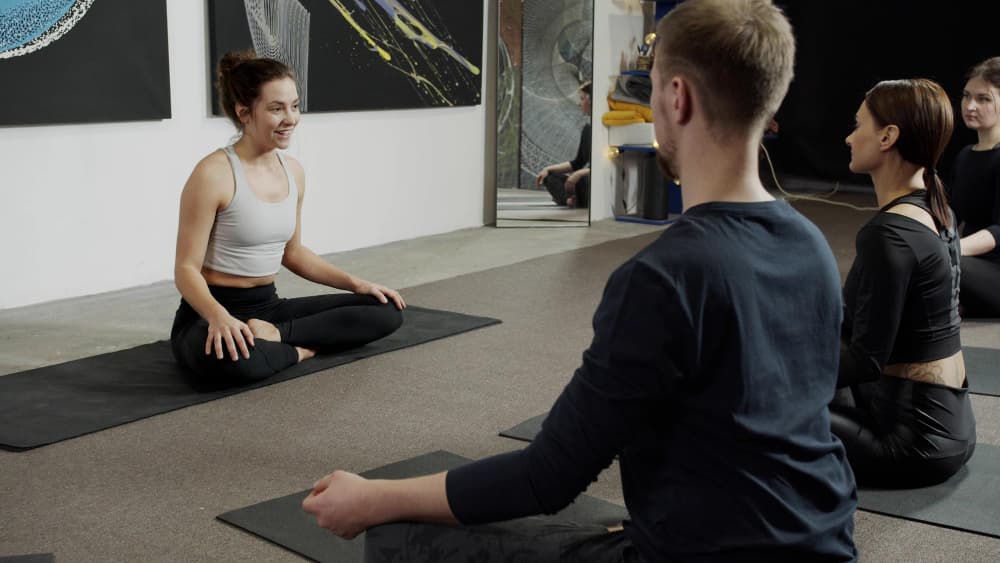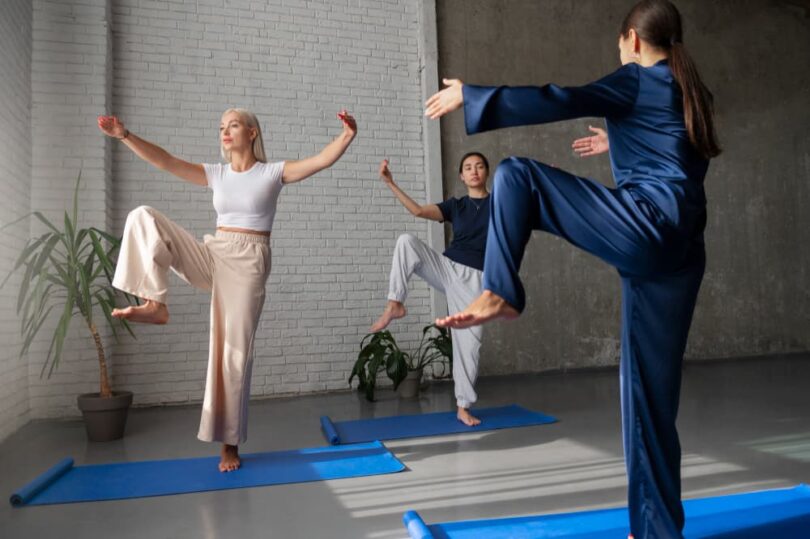Table of Contents
Introduction
Ashtanga Yoga Teacher Training offers an in-depth journey into the world of yoga, combining rigorous physical practice with profound spiritual teachings. Whether you’re looking to deepen your personal practice or aspire to teach, this guide covers everything you need to know. From understanding the roots and philosophy of Ashtanga Yoga to choosing the right training program, and from the core components of the curriculum to the practical considerations, we’ve got you covered. Get ready to embark on a transformative journey that could shape your future as a certified yoga instructor.
Introduction to Ashtanga Yoga Teacher Training
Definition and Overview of Ashtanga Yoga
Ashtanga Yoga is a dynamic, physically demanding practice that synchronizes breath with movement. Originating from the teachings of K. Pattabhi Jois, it involves a set sequence of postures designed to build strength, flexibility, and mental clarity. The practice is both challenging and rewarding, making it a popular choice for those seeking a disciplined approach to yoga.
Importance and Benefits of Teacher Training
Enrolling in an Ashtanga Yoga Teacher Training program is more than just learning to teach; it’s about deepening your own practice and understanding of yoga. You’ll gain knowledge about anatomy, philosophy, and teaching techniques, which not only enhance your personal practice but also prepare you to guide others effectively. Furthermore, the certification can open doors to teaching opportunities worldwide, allowing you to share the transformative power of yoga with others.
Understanding Ashtanga Yoga
History and Philosophy of Ashtanga Yoga
Ashtanga Yoga has a rich history rooted in ancient Indian traditions. Developed by K. Pattabhi Jois in the 20th century, it draws on the teachings of his guru, T. Krishnamacharya. The method emphasizes a disciplined practice of the Ashtanga Primary Series, which serves as the foundation for more advanced sequences. The philosophical underpinnings are based on the Yoga Sutras of Patanjali, which outline the eight limbs of yoga, including ethical guidelines, physical postures, breath control, and meditation.
Primary Series of Ashtanga Yoga
The Primary Series, also known as Yoga Chikitsa, is designed to align the body, purify the nervous system, and build strength and flexibility. It consists of a set sequence of postures, each linked with the breath in a flowing, dynamic routine. While challenging, the Primary Series is accessible to practitioners of all levels with appropriate modifications. Mastery of this series forms the basis for progressing to the intermediate and advanced sequences.
Choosing the Right Ashtanga Yoga Teacher Training Program
What to Look for in a Teacher Training Program
When selecting an Ashtanga Yoga Teacher Training program, it’s crucial to consider a few key factors to make the best choice. Firstly, look for programs accredited by reputable organizations like Yoga Alliance. This accreditation ensures the program meets high standards and that your certification will be recognized globally.
Additionally, review the curriculum carefully. A good program should cover essential topics such as the Ashtanga Primary Series, anatomy, teaching methodology, and yoga philosophy. Look for a balance between practical and theoretical components, ensuring you gain a holistic understanding of yoga.
Lastly, consider the instructors. Experienced, knowledgeable teachers can make a significant difference in your learning experience. Check their credentials, teaching style, and feedback from past students to gauge their effectiveness.
Top Locations for Ashtanga Yoga Teacher Training
Location plays a significant role in your training experience. Some of the top destinations for Ashtanga Yoga Teacher Training include:
- India: The birthplace of yoga, India offers authentic training experiences, often in serene settings like Mysore, Rishikesh, and Kerala.
- Bali: Known for its beautiful landscapes and vibrant yoga community, Bali is a popular choice for those seeking an inspiring environment.
- Thailand: With its tranquil beaches and affordable living costs, Thailand attracts many yoga enthusiasts for teacher training.
These locations not only provide excellent training programs but also immerse you in a supportive yoga culture, enhancing your overall experience.
Duration and Cost of Training Programs
The duration and cost of Ashtanga Yoga Teacher Training programs can vary significantly. Typically, a 200-hour training program spans over 3 to 4 weeks, while advanced courses might extend up to 500 hours over several months.
Costs also vary based on location, accommodation, and the reputation of the training center. On average, you can expect to invest between $1,500 and $3,000 for a 200-hour course. It’s essential to budget for additional expenses such as travel, meals, and study materials.
When planning your training, consider your financial situation and the time you can commit to it. While it may be tempting to opt for a shorter, cheaper program, investing in thorough, well-structured training will pay off in the long run.
Course Content and Structure
Core Components of Ashtanga Yoga Teacher Training
An Ashtanga Yoga Teacher Training program is packed with a variety of essential components that prepare you to become a skilled instructor. The heart of the training revolves around the Ashtanga Primary Series, a sequence of poses practiced with breath synchronization. You’ll learn each posture in detail, focusing on alignment, modifications, and adjustments to suit different body types and abilities.
Moreover, the training includes Pranayama (breath control) and meditation sessions. These practices are vital for developing mental clarity and inner calm, both for yourself and your future students. Understanding the subtleties of breath and its connection to movement can significantly deepen your practice.

Philosophy and Ethics in Yoga Teaching
Understanding the philosophical foundations of yoga is crucial for any teacher. The study of key texts such as the Yoga Sutras of Patanjali provides insights into the ethical and spiritual dimensions of yoga. These teachings offer guidance on how to live a balanced, mindful life, both on and off the mat.
Additionally, a good program will cover the ethical aspects of teaching yoga. This includes respecting the boundaries of students, fostering a safe and inclusive environment, and maintaining professionalism. Ethics in teaching not only builds trust with your students but also upholds the integrity of the yoga tradition.
Teaching Methodology and Practicum
Learning how to teach effectively is a cornerstone of any Ashtanga Yoga Teacher Training. You’ll explore various teaching methodologies, including how to structure a class, cueing techniques, and effective communication skills. Practicum sessions provide hands-on experience, allowing you to lead classes and receive constructive feedback from your peers and instructors.
A significant part of the practicum involves learning how to adjust and assist students safely. This skill is particularly important in Ashtanga Yoga, where physical adjustments can help deepen the practice and prevent injuries. You’ll practice these techniques under the guidance of experienced teachers, building confidence in your ability to support your students.
In summary, the course content and structure of an Ashtanga Yoga Teacher Training program are designed to equip you with the knowledge and skills needed to teach yoga effectively. From mastering the primary series and understanding yoga philosophy to learning practical teaching techniques and ethical guidelines, each component plays a vital role in your development as a yoga instructor.
Related Article: What is Ashtanga Yoga: History, Benefits, and Techniques
Benefits and Outcomes
Personal Growth and Development
Embarking on an Ashtanga Yoga Teacher Training journey brings significant personal growth and development. Physically, the rigorous practice of the Ashtanga Primary Series enhances strength, flexibility, and endurance. You’ll find that regular practice not only tones the body but also improves overall physical health. The demanding nature of Ashtanga Yoga pushes you to discover your physical limits and gradually expand them.
Mentally, the training fosters greater focus, discipline, and mindfulness. The combination of asana practice, pranayama, and meditation helps cultivate a calm and clear mind. This mental clarity can extend into your daily life, making you more present and aware of everything you do. Moreover, the philosophical teachings provide a deeper understanding of the mind-body connection, promoting a holistic sense of well-being.
Career Opportunities After Certification
Completing an Ashtanga Yoga Teacher Training opens up numerous career opportunities. With a certification from a recognized program, you can teach yoga at studios, gyms, and wellness centers or even start your own yoga business. The demand for skilled yoga instructors is growing, and having a specialization in Ashtanga Yoga sets you apart in the competitive market.
Besides teaching, there are other professional avenues in the yoga industry. You could lead workshops, retreats, and special training sessions. Writing about yoga for blogs, magazines, or books is another way to share your knowledge and passion. Additionally, you might find opportunities to collaborate with wellness programs, offering yoga as part of holistic health initiatives.
Being a certified yoga instructor not only provides financial benefits but also the satisfaction of helping others achieve better health and well-being. Your training equips you with the skills to inspire and guide students on their yoga journey, making a positive impact on their lives.
Through Ashtanga Yoga Teacher Training, you gain much more than just a teaching certification. The physical and mental benefits enhance your overall health and well-being, while the career opportunities allow you to share the transformative power of yoga with others. Whether you choose to teach, lead workshops, or write about yoga, the knowledge and skills you acquire during your training will open doors to a fulfilling and meaningful career.
Practical Considerations
Preparing for Your Training
Getting ready for your Ashtanga Yoga Teacher Training involves more than just packing your bags. To make the most of your experience, it’s important to prepare both physically and mentally. Start by gradually increasing your practice frequency and intensity. Familiarize yourself with the Ashtanga Primary Series if you haven’t already done so. This will help build the stamina and strength needed for the intensive training sessions.
Mentally, set clear intentions for why you’re undertaking this journey. Reflect on your goals and what you hope to achieve. Reading foundational texts like the Yoga Sutras of Patanjali can provide valuable insights and set a solid foundation for your philosophical studies.
Don’t forget the practicalities: Ensure your travel documents are in order, and arrange for accommodations if they’re not provided by the training program. Pack essentials such as comfortable yoga clothing, a good quality yoga mat, and any personal items that will help you feel at home during your stay.
Managing Challenges During Training
An Ashtanga Yoga Teacher Training can be intense and demanding, both physically and emotionally. It’s normal to face challenges, but with the right mindset and strategies, you can overcome them. Here are some tips to help you manage:
- Listen to Your Body: Pushing through pain can lead to injuries. Respect your limits and take breaks when needed. Use props and modifications to make poses accessible.
- Stay Hydrated and Eat Well: Fuel your body with nutritious foods and drink plenty of water. A balanced diet supports energy levels and recovery.
- Maintain a Positive Attitude: Keep an open mind and stay positive. Surround yourself with supportive peers and mentors. They can provide encouragement and help you stay motivated.
- Practice Mindfulness: Incorporate meditation and pranayama into your daily routine. These practices can help manage stress and keep you grounded.
- Rest and Recover: Ensure you get enough sleep and rest. Recovery time is crucial for both your body and mind.
FAQs
How Do You Become an Ashtanga Teacher?
To become an Ashtanga Yoga teacher, you need to complete a teacher training program that is typically accredited by organizations like Yoga Alliance. Here are the steps:
Practice Regularly: Develop a consistent practice of the Ashtanga Primary Series. Familiarize yourself with the poses and sequences.
Choose a Training Program: Select a reputable Ashtanga Yoga Teacher Training program. Look for accredited programs that offer a thorough curriculum covering asana, anatomy, philosophy, and teaching techniques.
Complete the Training: Attend the training, which usually includes both practical and theoretical components. This typically involves 200 hours of instruction for the basic certification.
Practice Teaching: Gain experience by teaching friends and family or at local studios. Practicum sessions during your training will help build confidence.
Continue Education: Many teachers pursue further training, such as 300-hour or 500-hour courses, to deepen their knowledge and enhance their teaching skills.
How Long Does It Take to Master Ashtanga?
Mastering Ashtanga Yoga is a lifelong journey and varies greatly from person to person. However, here are some general timelines:
Beginner Level: It may take several months to a year to become comfortable with the Ashtanga Primary Series. This includes learning the sequence, developing strength, and improving flexibility.
Intermediate Level: Progressing to the Intermediate Series and beyond can take several years of dedicated practice. This level requires a deeper understanding of the postures and advanced techniques.
Advanced Level: Mastery, which includes all series and a deep integration of breath, movement, and mindfulness, can take many years, often a decade or more.
Is Ashtanga the Hardest Yoga?
Ashtanga Yoga is known for its rigorous and disciplined approach, which can be challenging for many practitioners. However, whether it is the hardest form of yoga depends on individual experiences and perspectives. Here are some factors that contribute to its difficulty:
Physical Demands: The practice involves a set sequence of postures that require strength, flexibility, and endurance.
Consistency: Ashtanga is traditionally practiced six days a week, which can be demanding for both the body and mind.
Breath and Movement Synchronization: Maintaining a steady breath while moving through the sequence can be challenging, especially for beginners.
While it is a demanding practice, many find it highly rewarding and transformative. Other styles, such as Bikram or Power Yoga, can also be challenging in different ways.
What Is the Highest Level of Yoga Teacher Training?
The highest level of yoga teacher training is typically a 500-hour certification, which includes:
200-Hour Training: The foundational course covers basic asanas, anatomy, teaching techniques, and yoga philosophy.
300-Hour Training: An advanced course that builds on the 200-hour training, offering deeper insights into advanced postures, anatomy, and specialized teaching methods.
Upon completing both the 200-hour and 300-hour courses, you receive a 500-hour certification, recognized as the highest standard in yoga teacher training by organizations like Yoga Alliance.
Conclusion
Embarking on an Ashtanga Yoga Teacher Training journey is a transformative experience that goes beyond mastering physical postures. It’s about embracing a holistic practice that nurtures both the body and mind. Through rigorous training, you deepen your understanding of Ashtanga Yoga, enrich your personal practice, and gain the skills needed to guide others on their yoga journey.
Choosing the right program involves considering various factors such as accreditation, curriculum, and location. By preparing well and managing challenges, you can fully immerse yourself in the training, making the most of this valuable opportunity.
The benefits of completing an Ashtanga Yoga Teacher Training extend far beyond the mat. You’ll experience significant personal growth, improve your physical and mental well-being, and open up new career opportunities. Whether you aim to teach, lead workshops, or simply deepen your practice, the knowledge and insights gained from this training will have a lasting impact.
So, take that first step towards becoming a certified Ashtanga Yoga instructor. Embrace the journey with an open heart and mind, and you’ll find yourself transformed in ways you never imagined. Remember, the path of yoga is a lifelong journey, and your training is just the beginning. Here’s to a rewarding and enriching adventure in the world of Ashtanga Yoga!
Related Article: Somatic Yoga Poses: Benefits, Techniques, and Routines







